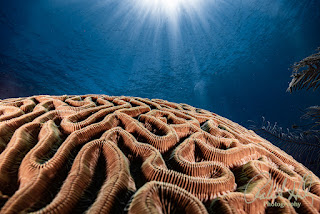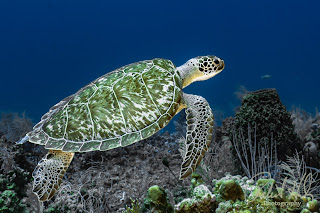Dealing With Low Light and High ISO: New AI Denoise Workflows
Have you ever surfaced from a twilight dive or an exciting deep wreck shoot, only to discover that your favorite photo is now marred by grainy noise? If you have, you’re certainly not alone! Many underwater photographers face this challenge. As you plunge deeper into the ocean, the available light diminishes quickly, making it necessary to increase your ISO settings. To capture those mesmerizing marine creatures in motion without motion blur, you might find yourself pushing your ISO to 1600, 3200, or even higher! Unfortunately, while this can result in breathtakingly sharp subjects, it often comes with the downside of unsightly digital noise.
But take heart! Thanks to Adobe Lightroom’s innovative AI Denoise feature, available in Lightroom Classic 14.2 and the Lightroom (Cloud) mobile version 9.3 and above, our approach to tackling noise in underwater photography has undergone a fantastic transformation. This post will guide you through the ins and outs of how AI Denoise operates, explain why it’s truly a game-changer for photographers working in low-light underwater environments, and provide you with seamless tips on how to incorporate this cutting-edge tool into your editing process. Get ready to save time while preserving the stunning detail in your underwater captures!
Why AI Denoise Is a Game-Changer for Underwater Photography
Traditional noise reduction tools in Lightroom, such as the Luminance and Color sliders found in the Detail panel, have been trusted companions for photographers looking to minimize grain in their images. However, these tools can sometimes result in a noticeable loss of image sharpness, which can be pretty frustrating, especially when capturing delicate subjects like a shy seahorse or a swiftly darting barracuda.
The introduction of the new AI Denoise tool marks a significant advancement in noise reduction technology. This innovative feature leverages the power of machine learning to distinguish between unwanted noise and actual details in your photos. It skillfully preserves essential elements, such as edges, vibrant colors, and intricate textures, even in challenging areas that might be shadowed or appear murky. Gone are the days of needing multiple back-and-forth trips to external plug-ins like Topaz DeNoise or DxO PureRAW. Now, with just a single click within Lightroom, you can achieve stunningly clear images with minimal effort. This means you can spend less time editing and more time enjoying your photography—whether you’re capturing those elusive ocean creatures or any other inspiring moment!
Step-by-Step: Applying AI Denoise in Lightroom Classic 14.2
🎯 Best used on RAW files for optimal results
- Open the Develop Module
- Shortcut: D
- Navigate to your low-light or high ISO underwater image.
- Go to the Detail Panel
- Location: Right-hand sidebar, below the Tone Curve.
- Click ‘Denoise…’
- A pop-up will preview the effect.
- Use the Amount slider to adjust the effect’s intensity.
(I typically start at 50 - 70 for ISO 3200 underwater shots.) - Click ‘Enhance’
- Lightroom will create a new DNG copy of the image with AI Denoise applied.
- You’ll see this labeled as “_Enhanced-NR” next to your original.
🖱️ Pro Tip: Use Cmd/Ctrl + E to jump to external editors like Photoshop if you want to layer additional creative effects after AI Denoise.
Example 1: Cave Dive at 80 Feet - ISO 4000
The photograph captures a picturesque scene of a diver gracefully entering a swim-through tunnel. This moody image, taken with available light, initially struggled with noticeable color blotches and persistent shadow noise, detracting from its overall quality. After applying the Denoise effect at a strength of 70%, the transformation was remarkable. The details of the diver were enhanced beautifully, allowing the natural ambient light rays to shine through effectively. Importantly, no additional sharpening was needed to maintain the image’s clarity and depth. Overall, the post-editing process not only improved the visual appeal but also preserved the essence of the underwater experience.
Time saved: What used to take 10-15 minutes to tweak noise sliders now takes just 1 minute, including file processing.
Example 2: Macro Strobe Shot with ISO 2500
In photography, even when using strobes, there are moments when adjusting to a high ISO setting becomes necessary to effectively freeze motion. For instance, in a photograph capturing a jawfish that is diligently guarding its eggs, the image exhibited fine particles and background shadows that were noticeably affected by chroma noise, which creates unwanted color variations in the picture. To enhance this image, an AI Denoise tool was employed, which successfully smoothed out the distracting elements in the background while preserving the delicate textures of the eggs, allowing their intricate details to remain clear and visually appealing.
Keyboard shortcut to preview before/after:
\ (backslash) - toggles the original vs. processed image.
Example 3: Night Dive — Ambient-Only Shooting
Night dives offer a distinctive set of challenges for photographers. The limited natural light and absence of strobe coverage necessitate that we push the camera’s ISO to its maximum levels, which can compromise image quality. In my recent dive, I captured a RAW file at ISO 6400. To enhance the image, I utilized an AI Denoise tool, which effectively reduced noise. Additionally, I applied AI Masking (by pressing Shift + W), allowing me to specifically brighten the subject of the photograph while ensuring the background remained soft and understated. This technique helps draw attention to the main focus of the image without losing the essence of the underwater environment.
By combining AI tools, this workflow creates a powerful synergy:
- AI Denoise handles image cleanup
- AI Masking isolates and enhances subjects
- Auto Settings (Shift + U) can give you a smart starting point before refinements
Lightroom (Cloud and Mobile) Workflow
In the Lightroom Mobile app (v9.3+), AI Denoise has finally arrived! It runs slightly slower on mobile devices but delivers the same results. Tap the ‘Detail’ panel, select Denoise, and adjust the strength.
⛵ Perfect for travel: I now denoise RAW images directly on my Tablet while still on the dive boat, then sync back to my desktop catalog later for final edits.
Bonus: Speed Up Your Workflow with These Tips
- Batch Flagging: Use P to flag images for Denoising right after import.
- Filter High ISOs Only: Press * to enter Library Grid mode and filter by ISO > 1600.
- Auto-Sync Denoised Files: After applying Denoise, use Cmd/Ctrl + Shift + S to sync basic global edits to the enhanced file.
- Use Presets: Save your Denoise settings as part of a Develop Preset for “Low Light Dives” to apply consistently with one click.
Final Thoughts
Underwater photography presents a unique set of challenges that can make capturing perfect images quite difficult. Issues such as limited visibility, tricky lighting conditions, and movement underwater are just a few of the obstacles photographers face. Fortunately, with the introduction of Lightroom’s new AI Denoise feature, one significant problem can now be easily managed.
This innovative tool is not only efficient but also incredibly smart, and it has been specifically designed to handle the unique challenges presented by underwater environments. By allowing AI Denoise to take care of noise reduction, you can spend more time focusing on the creative aspects of your photography.
No matter if you’re out and about editing your images with Lightroom Mobile or you’re settled in your office using Classic 14.2, this remarkable tool is designed to support you every step of the way. Often, high ISO photos can be a bit tricky, as they tend to pick up unwanted noise that detracts from their quality. Thankfully, with the AI Denoise feature, you can transform these noisy images into beautiful visuals that are not only suitable for printing but also perfect for showcasing. This innovative tool simplifies your editing process, ensuring that your underwater photography stands out even more. With its impressive results, you can genuinely feel taken in by the images you create.
📣 What’s Your Experience with AI Denoise?
Have you tried it on a recent dive trip? Got a before/after story to share? Tag me with your edits using #RobertHerbPhotography or drop a comment below.
📬Want More?
I’m creating an online training program specifically designed for underwater enthusiasts who want to refine their post-processing skills using Lightroom. Email me at bob@robertherb.com or visit the Training Page to join the early access list.
Follow my blog for weekly tips at Robert Herb Blog and share your edits with #RobertHerbPhotography—I’d love to see how you bring your images to life!
- 💡 Read more Lightroom tips and get weekly updates when new blogs are published at the Robert Herb Blog.
- 💡 Join my upcoming online training program – Learn to enhance your underwater shots with Adobe Lightroom! Sign up for a FREE "Before & After" Gallery.
- 💡 Share your processed photos on social media using #RobertHerbPhotography.
- 💡 Questions or want help with your Lightroom workflow? Email me at bob@robertherb.com
Written by Robert Herb – Empowering underwater photographers to capture and enhance the beauty of our oceans.
Stay tuned for more in-depth insights into underwater photography. Let’s dive deeper into the art and craft of capturing the marine world! If you have any comments or suggestions, I’d love to hear them.
Get ready for an exciting underwater photography adventure! For more details on my upcoming online training course, check out my "Training" page at RobertHerb.com or email me at bob@robertherb.com.
Sincerely,
Bob Herb
|
|





Comments
Post a Comment
Please let me know your comments.